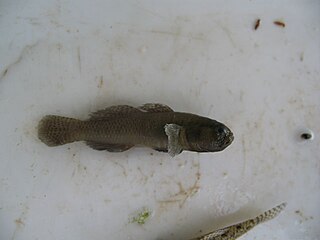
Economidichthys is a genus of freshwater gobies endemic to Greece. The name of this genus honours the Greek ichthyologist Panos Economidis.
Silhouettea is a genus of gobies native to the Indian Ocean and the western Pacific Ocean. The name of this genus refers to the island of Silhouette in the Seychelles where the type specimens of the type species, Silhouettea insinuans, were collected.

Lesueurigobius is a genus of gobies native to the eastern Atlantic Ocean. The generic name honours the French naturalist Charles Alexandre Lesueur (1778-1846), for whom the type species, Lesueurigobius suerii, was named, Georg Duncker's name Lesueuria being preoccupied by a genus of comb jellies.

Didogobius is a genus of small marine fish in the family Gobiidae, the true gobies. They are native to the eastern Atlantic Ocean and the Mediterranean Sea. The name of the genus is a compound noun made up of Dido, the mythical founder and first queen of Carthage, and the Latin gobius meaning "goby".

Koumansetta is a small genus of gobies native to the Indian Ocean and the western Pacific Ocean. The name of this genus honours the Dutch ichthyologist and goby taxonomist Frederik Petrus Koumans (1905-1977) of the Rijksmuseum van Natuurlijke Historie in Leiden, Netherlands, who had written a description of Koumansetta rainfordi following a visit to the Australian Museum in Sydney in 1938 but did not name it. The outbreak of World War 2 meant that Whitley's correspondence with Koumans was interrupted, so he named this genus after him, noting “which will enshrine memories of happier days of our meetings in Leiden and Sydney”.
Elacatinus chancei, the shortstripe goby, is a species of ray-finned fish in the family Gobiidae. It lives inside or on the surface of a sponge and occurs in tropical waters in the west central Atlantic Ocean, the Bahamas, the Antilles, and Venezuela.
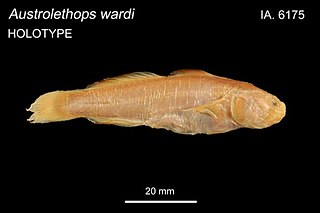
The small-eyed goby is a species of goby native to tropical reefs of the Indian Ocean through the western Pacific Ocean where it inhabits areas of coral rubble. As its common name suggests, this species has particularly small eyes. This species grows to a length of 6 centimetres (2.4 in) TL. This species is the only known member of its genus. The small-eyed goby is specialised to feed on seagrass and they share a burrows with mud lobsters of the genus Thalassina. The specific name honours Charles Melbourne Ward (1903-1966), the Australian actor, naturalist and collector of specimens who collected the type specimen.
Bollmannia is a genus of gobies native to the Atlantic and Pacific coasts of the Americas. The generic name honours the American naturalist Charles Harvey Bollman (1868–1889).

Buenia is a genus of gobies native to the eastern Atlantic Ocean and the Mediterranean Sea. The name of the genus and the common name of the type species honour Fernando de Buen y Lozano (1895-1962), the Spanish oceanographer and marine biologist.
Echinogobius hayashii, the cheek-streaked goby, is a species of goby native to the eastern Indian Ocean and the western Pacific Ocean from Australia to Japan. This species can be found at depths of from 1 to 20 metres living in areas with strong tidal currents and a sandy substrate. This species grows to a length of 7 centimetres (2.8 in) SL. This species is the only known member of its genus. The specific name honours Masayoshi Hayashi, a curator at Yokosuka City Museum, who collected the type specimens.
Ginsburgellus novemlineatus, the Nineline goby, is a species of goby native to tropical reefs of the western Atlantic Ocean and the Caribbean Sea. It is frequently found associated with the sea urchin Echinometra lucunter, living underneath the urchin. This species grows to a length of 2.5 centimetres (0.98 in) TL. This species can also be found in the aquarium trade. This species is the only known member of its genus, the name of which honours the ichthyologist Isaac Ginsburg (1886-1975) of the U.S. National Museum who had an interest in gobies.

Kelloggella is a genus of fish in the family Gobiidae, the gobies. This genus is distributed in the Indian and Pacific Oceans. The genus name honours the American entomologist Vernon Lyman Kellogg (1867-1937) of Stanford University, the discoverer of Kelloggella cardinalis.
Larsonella pumila is a species of goby native to the Indian Ocean from the coast of Africa to the western Pacific Ocean. This species grows to a length of 1.9 centimetres (0.75 in) SL. This species is the only known member of its genus. The specific name honours the ichthyologist Helen K. Larson who is the Curator of Fishes at the Museum and Art Gallery of the Northern Territory in Darwin, for her work on the taxonomy of Indo-Pacific gobies.
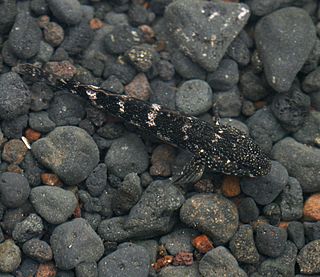
Mauligobius is a genus of ray-finned fish from the family Gobiidae native to the eastern Atlantic Ocean. The name of this genus honours the ichthyologist and taxidermist Günther Edmund Maul (1909-1997) of the Museu Municipal do Funchal on Madeira for his assistance in making material and information available which the author, Peter Miller, used in his research on Macronesian gobies.
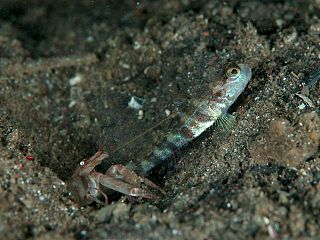
Myersina is a genus of ray-finned fish from the family Gobiidae, the true gobies which are found from the Atlantic coast of South Africa through the Indian Ocean to the western Pacific Ocean. The generic name honours the American ichthyologist George S. Myers (1905-1985) who was a younger colleague of Herre's at the time at which he described the genus and who went on to be president of the American Society of Ichthyologists and Herpetologists, the head of the Division of Fishes at the United States National Museum and an ichthyologist for the United States Fish and Wildlife Service.
Parrella is a genus of gobies native to the tropical waters of the Pacific and Atlantic coasts of the Americas. The name of this genus honours the Norwegian American marine biologist, zoologist and oceanographer Albert Eide Parr (1900-1991).
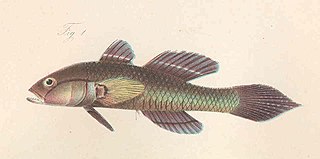
Porogobius schlegelii is a species of goby native to brackish and fresh waters along the Atlantic coast of Africa from Senegal to the Democratic Republic of the Congo. It is also found in the islands of the Gulf of Guinea and Cape Verde. It occurs in inshore waters in lagoons, estuaries, the lower reaches of rivers and mangrove swamps. This species grows to a length of 14.9 centimetres (5.9 in) TL. This species is the only known member of its genus. The specific name honours the ichthyologist Hermann Schlegel (1804-1884) who supplied Günther with the type specimen from the Natural History Museum in Leiden.
Wheelerigobius is a genus of gobies native to the eastern Atlantic Ocean. The name of this genus honours the British ichthyologist Alwyne C. Wheeler (1929-2005) who was the curator of Fishes at the British Museum.

Yongeichthys is a genus of gobies native to the coastal waters of the Atlantic coast of Africa, Indian Ocean and the western Pacific Ocean. The name of this genus honours the zoologist Charles Maurice Yonge (1899-1986), who led the Great Barrier Reef Expedition of 1928-1929.
The toadfish goby is a species of bony fish in the family Gobiidae which is found in areas of sandy substrates among coral reefs. It occurs in the western Atlantic Ocean from the Bahamas south through the Caribbean Sea as well as along the Central and South American coast from Belize to Santa Marta, Colombia. It is the only species in the monotypic genus Cryptopsilotris, although it was formerly classified under Psilotris and its generic name means "hidden Pilotris", meaning that it was hidden within that genus.












